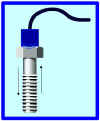We will show you every screen and every parameter that may be
useful. We will only have to cover those
screens that are used differently.
-
Startup screen.
SAME:
This
startup screen lets you choose between recording new tension data or playing
back old tension data. In the manufacturer #2's application, we just want to
record new tension readings.
-
Press
the button Labeled "New Bolt Enter Parameters". SAME:
You can start a new data file, or add tension data to a
previous data file.
-
Enter the bolt length. SAME:
-
Enter the stretch
coefficient for this type of bolt. In
addition, also enter the temperature coefficient. See the example of how
SureBolt helped measure this temperature coefficient.

-
Enter your bolt's file name. SAME:
-
Place the transducer and get a good signal. Choose the
signal echo and get ready to record. In addition also
enter the bolt's temperature.


-
Reminder screen. Good coupling? Zero tension?
Correct temperature?
-
Ready to take tension readings. SAME:
Just torque the
bolt and watch the tension increase.
-
Monitor & Record Tension. As the torque wrench is set at
different torque values, you can see the bolt tension increase. In
addition, also enter the temperature, if it changes.
-
Same Data In Graph Form.
SAME:
Real-Time graphing of tension data. Notice the
sensitivity to even the smallest tension changes. Press the small pictures to enlarge
(64 Kbytes) and see the
steps you will take. Notice the different torque wrench settings. Notice the
sensitivity of SureBolt.
-
Back To The Startup Screen.
SAME: This time you will choose
to playback the data you just recorded. Manufacturer # 1 only does this on
the first "training" bolt. They only want to verify that the user
is operating SureBolt correctly. Press the small picture to enlarge (57 Kbytes) and see the
steps you will take.
-
Immediately Playback Data.
SAME: Graph
the recorded tensions to verify that all is working. Press the small picture to enlarge
(60 Kbytes).
-
Write Excel Report. SAME:
Open Microsoft
Excel (included with SureBolt), load data file, and make your report. Press
to see the data recorded.
-
Check the bolt tension a month
later. Just follow the same steps as before with ONE EXCEPTION:
When you get to the second step (select New Bolt Enter Parameters or Add
Tension Data To Existing Bolt File button), select the "Add Tension
..." button instead of the "New Bolt ..." button.

-
Place your transducer on the same bolt.
SureBolt will have already loaded all the parameters for you. SureBolt will take you to
the real-time tension monitoring screen. Just keep adjusting the transducer
until you see the same amplitude and general shape echo. Note: This is why
you must use the same transducer.

-
Press the green "Record ..." button.
-
And then exit SureBolt until next month.

![]()